| Human Spaceflight Launch Vehicle Project by Tim Nelson |  | History Although a dream for centuries, the reality of human spaceflight began in 1961 with Yuri Gagarin's single orbit in Vostok 1. The 1960s were the 'golden age' of human space exploration, driven by a quest for knowledge and good old-fashioned Cold War rivalry between the U.S.A. and U.S.S.R. The rapid advancement of spaceflight technology during this time was remarkable, underscored by the relatively slow pace of progress since the early 1970s. Some detailed accounts of human spaceflight history and technology can be found in the References. 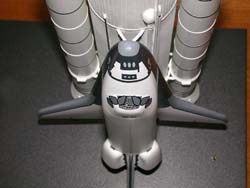 As a kid growing up in Houston during the Apollo years, I became fascinated with spaceflight. I built most of the Revell spacecraft kits from the 1960s, and loved them. In my adult years, however, I grew frustrated at the lack of decent, accurate model kits of factual space hardware. The single biggest factor in ending this drought in recent years has been Glenn Johnson and his line of RealSpace Models kits. His offerings include conversions of 'mainstream' kits as well as stand-alone rocket/spacecraft kits in various scales. What galvanized my initial interest was the realization that, with some of these recent kits, I could model the history of human spaceflight in a series of 1/144th scale launch vehicles. As a kid growing up in Houston during the Apollo years, I became fascinated with spaceflight. I built most of the Revell spacecraft kits from the 1960s, and loved them. In my adult years, however, I grew frustrated at the lack of decent, accurate model kits of factual space hardware. The single biggest factor in ending this drought in recent years has been Glenn Johnson and his line of RealSpace Models kits. His offerings include conversions of 'mainstream' kits as well as stand-alone rocket/spacecraft kits in various scales. What galvanized my initial interest was the realization that, with some of these recent kits, I could model the history of human spaceflight in a series of 1/144th scale launch vehicles. As of 2002, every human being that has journeyed into space has done so on one of the following launch vehicles (listed in chronological order by first flight): Vostok R-7/A-1/SL-3 (U.S.S.R.)
Mercury-Redstone (U.S.A.)
Mercury-Atlas (U.S.A.)
Voskhod A-2/SL-4 (U.S.S.R.)
Gemini-Titan (U.S.A.)
Soyuz A-2/SL-4 (U.S.S.R.)
Apollo Saturn 1B (U.S.A.)
Apollo Saturn V (U.S.A.)
Space Shuttle (U.S.A.) Thus, I set out on a project to model these vehicles, with the goal of finishing in that famed 'space' year of 2001 (April 12, 2001 was both the 40th anniversary of the first human in space and the 20th anniversary of the first flight of the Space Shuttle). My working title for this collection was 'Size Matters', but the final (admittedly more sensible) name became 'Human Spaceflight: The First Small Steps!' (NOTE: For those wondering, 'What about the Soviet shuttle 'Buran'?' Its single flight in 1988 was unmanned and it thus did not qualify for my human spaceflight project.) The Models Vostok R-7 (A-1) 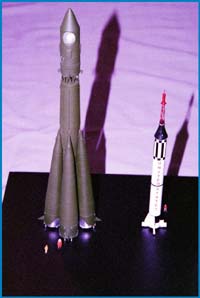 Comments: The Soviet R-7 ICBM was the basis for the first rocket to launch a man (and woman) into space, the earlier Sputnik launch vehicle, later Soviet/Russian spacecraft, and literally hundreds of satellites. In various forms, it has been in continuous use for over 45 years and is by far the world's most used launch vehicle. Comments: The Soviet R-7 ICBM was the basis for the first rocket to launch a man (and woman) into space, the earlier Sputnik launch vehicle, later Soviet/Russian spacecraft, and literally hundreds of satellites. In various forms, it has been in continuous use for over 45 years and is by far the world's most used launch vehicle. Basic kit: Based on the Apex Vostok kit, which was was the best available kit of the subject when this phase of the project was going on in 1999. It is much more faithful to scale than the old Airfix kit, although the upper stage is rather crude. In 2002, RealSpace Models released a kit of this vehicle (naturally), which is undoubtedly the preferred kit now. One nice touch in the old Airfix kit is a 1/144 suited cosmonaut, which I duly employed in the final display to help illustrate scale. Modifications: The upper stage was modified from the Rho Models* Voskhod 1 resin conversion kit for improved accuracy. The photo-etch attachment struts for the four strap-on boosters were also from Rho Models. The four upper stage thrusters were added from the Airfix kit. The interstage truss was scratch-built. *Note: Rho Models was recently sold to RealSpace Models, which is continuing to offer Julius De Roo's extensive line of Soviet/Russian spacecraft models. Mercury - Redstone Comments: Alan Shepard and Gus Grissom rode this little booster on 15 minute ballistic hops into space in 1961. Compare the size of this first American manned launch vehicle with its Russian counterpart. Basic kit: RealSpace Models resin kit. Decals are generic for this vehicle, but lack the white UNITED STATES insignias and individual logos ('Freedom 7' or 'Liberty Bell 7') for the Mercury spacecraft itself. Built 1998. Modifications: The tiny Mercury spacecraft has a molded rectangular window shape associated with the orbital (Atlas) version. I sanded it smooth and drilled a circular window hole to replicate the porthole of this sub-orbital version of the Mercury spacecraft. Mercury - Atlas 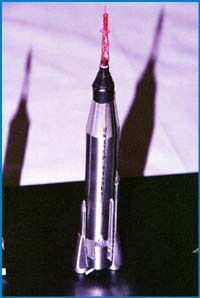 Comments: This vehicle carried John Glenn, Scott Carpenter, Wally Schirra, and Gordon Cooper into orbit in 1962-63. Great footage of Mercury-Atlas launches (and spectacular early Atlas failures) can be seen in the 1983 film 'The Right Stuff.' Comments: This vehicle carried John Glenn, Scott Carpenter, Wally Schirra, and Gordon Cooper into orbit in 1962-63. Great footage of Mercury-Atlas launches (and spectacular early Atlas failures) can be seen in the 1983 film 'The Right Stuff.' Basic kit: RealSpace Models resin kit. The decals contain the Atlas markings for John Glenn's flight, but lack the white UNITED STATES insignias and 'Friendship 7' logo for the Mercury spacecraft itself. I used Bare Metal Foil for the buffed aluminum finish on the Atlas. If I were doing it now, I would be inclined to use Alclad. Built 1998. Modifications: I scratchbuilt the exhaust line running down the side of the booster. I think this part may have been omitted from my kit. The vent line extending diagonally down from the bottom of the Atlas actually should extend below the bottom plane of the engine nozzles; since I didn't want to make a special mount for this model, I opted to shorten this line to stay above the ground plane. Voskhod SL-4 (A-2)  Comments: The Voskhod spacecraft was essentially a Vostok with one or two extra men crammed inside. The first three man crew and the first extra-vehicular activity (EVA) or 'space walk' were the major milestones of the two flight Voskhod program in 1964-65. Comments: The Voskhod spacecraft was essentially a Vostok with one or two extra men crammed inside. The first three man crew and the first extra-vehicular activity (EVA) or 'space walk' were the major milestones of the two flight Voskhod program in 1964-65. Basic kit: Also based on Apex Vostok kit. The comments on this kit in the Vostok summary are applicable here also. Built 1999. Modifications: The upper stage is the Rho Models Voskhod 2 resin conversion kit, including the interstage truss and booster attachment struts. The model represents Voskhod 2; the odd protrusion on the back of the nose fairing protected the EVA airlock during launch. Gemini - Titan 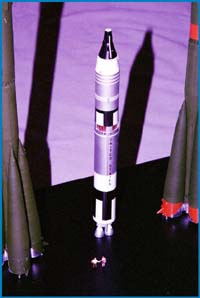 Comments: Perhaps the most interesting human spaceflight program, with a wealth of technical accomplishments achieved during 1965-66. This program set the stage for the Apollo lunar flights by validating all of the key technologies that would be necessary: long duration flights, precision orbital maneuvering, orbital rendezvous and docking, and EVA. The Gemini astronauts formed the nucleus of the men that would go to the moon during 1968-72. Comments: Perhaps the most interesting human spaceflight program, with a wealth of technical accomplishments achieved during 1965-66. This program set the stage for the Apollo lunar flights by validating all of the key technologies that would be necessary: long duration flights, precision orbital maneuvering, orbital rendezvous and docking, and EVA. The Gemini astronauts formed the nucleus of the men that would go to the moon during 1968-72. Basic kit: RealSpace Models resin kit. Built 1998. Modifications: Small wires were used to add detail to the interstage area and the first stage rocket nozzle structure. Soyuz SL-4 (A-2) 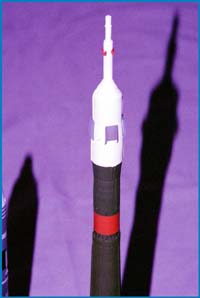 Comments: The first Soyuz mission ended in Vladimir Komarov's death following a tumbling re-entry in 1967. Soyuz later became a workhorse of the Soviet/Russian space program, and enabled the very long duration Salyut and Mir space station missions. It is still in use today and is an integral part of the International Space Station program. Comments: The first Soyuz mission ended in Vladimir Komarov's death following a tumbling re-entry in 1967. Soyuz later became a workhorse of the Soviet/Russian space program, and enabled the very long duration Salyut and Mir space station missions. It is still in use today and is an integral part of the International Space Station program. Basic kit: Based on the Apex Vostok kit, with comments as above. Built 1999. Modifications: The upper stage is the RealSpace Models Soyuz TM resin conversion kit, with Rho Models stabilizer flaps, interstage truss, and booster attachment struts. The RealSpace conversion came with molded stabilizer flaps*, which were not too convincing (I think this kit has since been modified). I sanded them off and replaced them with the Rho photoetch flaps that were included for reasons unknown (but welcome) in the Voskhod 2 conversion kit discussed above. The model is representative of Soyuz TM configuration used to support the Mir space station. *Note: The stabilizer flaps are normally tucked against the side of the fairing that protects the Soyuz spacecraft during launch. In the event of an abort early during the launch, the Soyuz section would be pulled away from the rest of the stack by an escape tower. During this process, the top of each stabilizer flap pivots out and down 90 degrees, and the deployed flaps serve to improve the aerodynamic stability of the separated section. An odd design solution, but one that has functioned well for decades. Apollo Saturn 1B Comments: Now almost forgotten except by space buffs, this vehicle launched five manned missions: Apollo 7, Skylab 1/2/3, and the Apollo part of Apollo-Soyuz. The tragic Apollo 1 fire in January, 1967 occurred atop a Saturn 1B. I saw one of these babies (Skylab 2) launch in person in 1973, so I have a special affection for it. Basic kit: RealSpace Models resin kit. This kit is spectacular in size, weight, and appearance. It is far superior to the old Airfix kit, and although expensive, the old Airfix kit cannot be had cheap anymore either. The RealSpace kit contains parts and excellent decals for individual test vehicles, Apollo 1 with the Block 1 spacecraft, or the actual manned flights with the Block 2 spacecraft. My model is in the markings of the 1st Apollo flight, Apollo 7 in October, 1968. Built 2000. Modifications: None. (That's right, none.) Apollo Saturn V 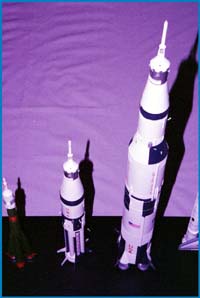 Comments: The mighty Saturn V. The greatest rocket in history, rivalled only by the Soviet N-1 lunar booster. Since the latter kept blowing up, the former wears the crown. It will always be famous as the vehicle to launch the first human lunar expeditions, and perhaps the most amazing thing in hindsight is that we threw all of its capability away. I saw Apollo 17 on the launch pad about three weeks before launch in 1972, but one of my few regrets in life is never seeing a Saturn V thunder into space. Comments: The mighty Saturn V. The greatest rocket in history, rivalled only by the Soviet N-1 lunar booster. Since the latter kept blowing up, the former wears the crown. It will always be famous as the vehicle to launch the first human lunar expeditions, and perhaps the most amazing thing in hindsight is that we threw all of its capability away. I saw Apollo 17 on the launch pad about three weeks before launch in 1972, but one of my few regrets in life is never seeing a Saturn V thunder into space. Basic kit: Revell-Monogram kit, which originates from the late 1960s but has been re-issued many times. This kit still makes a fun and educational model for kids, but has some accuracy problems. (As is always the case, a fine and accurate Saturn V is in development and set for imminent release by RealSpace Models.) Built 2000. Modifications: The third stage fairing and (Block 1) Apollo spacecraft were discarded in favor of the far superior RealSpace Models Block 2 Apollo resin conversion kit. A great set of decals is available from Tango Papa, which is not only accurate but contains umpteen duplicates of everything you need, making for a very forgiving decal application process. The model was built (with some minor manipulation of the ullage rocket fairings around the base of the second stage) in the typical configuration for Apollo 8-14, and bears markings for Apollo 11. Space Shuttle 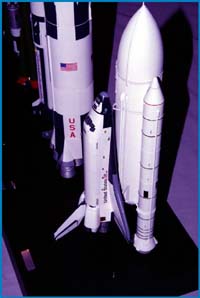 Comments: The world's first reusable spacecraft. Carrying humans into space on a regular basis since 1981, the remarkable Space Shuttle is easy to take for granted. Don't. Comments: The world's first reusable spacecraft. Carrying humans into space on a regular basis since 1981, the remarkable Space Shuttle is easy to take for granted. Don't. Basic kit: Revell-Monogram kit. The orbiter has major fit problems, but has the right proportions. Dealing with the toy-like cargo bay doors is an epic problem. The solid rocket boosters lack much in the way of detail, and share the fit problems of the orbiter. The external tank was molded in the late 1970s, and sports large horizontal bands which are in reality quite invisible beneath the insulation applied on the exterior. Built 2001. Modifications: The external tank bands were sanded off, and most of the tank was roughed up with sandpaper and liquid cement to achieve the rough texture of the original. RealSpace Models makes a nice set of shuttle main engine nozzles and decals, which I eagerly used. The model bears the markings of the first space shuttle flight, STS-1 (Columbia) in April, 1981. The now familiar orange (unpainted) external tank first appeared on STS-3 in March, 1982. The Base After some searching, I found the base I wanted for the rockets at IKEA (ya sure!) It's actually a shelf made of particle board with a hard black veneer. It is quite thick (2 inches), which gives it a definite presence on the table. 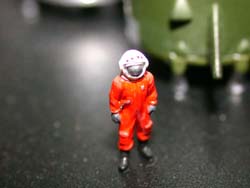 For scale, I wanted to add some figures, but good figures in 1/144th scale are hard to come by. I did use the small spacesuited cosmonaut figure in the Airfix 1/144th scale Vostok kit, but most of the figures on the base are actually N-scale (1/160). They exhibit a nice variety of poses and accomplish the goal of emphasizing the massive size of some of these vehicles. For scale, I wanted to add some figures, but good figures in 1/144th scale are hard to come by. I did use the small spacesuited cosmonaut figure in the Airfix 1/144th scale Vostok kit, but most of the figures on the base are actually N-scale (1/160). They exhibit a nice variety of poses and accomplish the goal of emphasizing the massive size of some of these vehicles. Brass rod was used to mount the rockets to the base, and they were placed left-to-right in order of first manned flight. Conclusion This project was very rewarding during four years of sporadic work. I wanted to create something that might evoke a little of the excitement of space exploration in others, especially kids. It is shocking to think that any person alive in 2002 younger than 21 would not have witnessed the first flight of any of the vehicles represented in this project. The project was a great introduction to many materials and techniques that were new to me. I can certainly see improvement in some of my skills from the earliest models in the series (the Mercury/Gemini vehicles) to the final installments (the Saturns and Space Shuttle). Of course, now I'd like to do 'em all over again with what I've learned, but that sure ain't gonna happen. Now, I'd like to see someone do this kind of collection in 1/72nd scale! (Yes, RealSpace Models is well on the way to producing a line of 1/72nd launch vehicles!) References -
Rockets of the World, Peter Alway (2nd ed.) -
Space Shuttle, Space in Miniature #3, Michael J. Mackowski -
Space Shuttle Walk-Around, Lou Drendel -
A Man on the Moon, Andrew Chaikin -
The Right Stuff, Tom Wolfe Resources RealSpace Models If you are interested in modeling historical spacecraft or launch vehicles, do yourself a big favor and explore Glenn Johnson's ever-expanding product line. It's just about one stop shopping for the space modeler, and contains links to many other space and space modeling related web sites. Glenn's 'Portfolio' spread in the February, 1997 issue of FineScale Modeler was one of the inspirations for this project. | 







|

 As a kid growing up in Houston during the Apollo years, I became fascinated with spaceflight. I built most of the Revell spacecraft kits from the 1960s, and loved them. In my adult years, however, I grew frustrated at the lack of decent, accurate model kits of factual space hardware. The single biggest factor in ending this drought in recent years has been Glenn Johnson and his line of RealSpace Models kits. His offerings include conversions of 'mainstream' kits as well as stand-alone rocket/spacecraft kits in various scales. What galvanized my initial interest was the realization that, with some of these recent kits, I could model the history of human spaceflight in a series of 1/144th scale launch vehicles.
As a kid growing up in Houston during the Apollo years, I became fascinated with spaceflight. I built most of the Revell spacecraft kits from the 1960s, and loved them. In my adult years, however, I grew frustrated at the lack of decent, accurate model kits of factual space hardware. The single biggest factor in ending this drought in recent years has been Glenn Johnson and his line of RealSpace Models kits. His offerings include conversions of 'mainstream' kits as well as stand-alone rocket/spacecraft kits in various scales. What galvanized my initial interest was the realization that, with some of these recent kits, I could model the history of human spaceflight in a series of 1/144th scale launch vehicles. Comments: The Soviet R-7 ICBM was the basis for the first rocket to launch a man (and woman) into space, the earlier Sputnik launch vehicle, later Soviet/Russian spacecraft, and literally hundreds of satellites. In various forms, it has been in continuous use for over 45 years and is by far the world's most used launch vehicle.
Comments: The Soviet R-7 ICBM was the basis for the first rocket to launch a man (and woman) into space, the earlier Sputnik launch vehicle, later Soviet/Russian spacecraft, and literally hundreds of satellites. In various forms, it has been in continuous use for over 45 years and is by far the world's most used launch vehicle. Comments: This vehicle carried John Glenn, Scott Carpenter, Wally Schirra, and Gordon Cooper into orbit in 1962-63. Great footage of Mercury-Atlas launches (and spectacular early Atlas failures) can be seen in the 1983 film 'The Right Stuff.'
Comments: This vehicle carried John Glenn, Scott Carpenter, Wally Schirra, and Gordon Cooper into orbit in 1962-63. Great footage of Mercury-Atlas launches (and spectacular early Atlas failures) can be seen in the 1983 film 'The Right Stuff.' Comments: The Voskhod spacecraft was essentially a Vostok with one or two extra men crammed inside. The first three man crew and the first extra-vehicular activity (EVA) or 'space walk' were the major milestones of the two flight Voskhod program in 1964-65.
Comments: The Voskhod spacecraft was essentially a Vostok with one or two extra men crammed inside. The first three man crew and the first extra-vehicular activity (EVA) or 'space walk' were the major milestones of the two flight Voskhod program in 1964-65.  Comments: Perhaps the most interesting human spaceflight program, with a wealth of technical accomplishments achieved during 1965-66. This program set the stage for the Apollo lunar flights by validating all of the key technologies that would be necessary: long duration flights, precision orbital maneuvering, orbital rendezvous and docking, and EVA. The Gemini astronauts formed the nucleus of the men that would go to the moon during 1968-72.
Comments: Perhaps the most interesting human spaceflight program, with a wealth of technical accomplishments achieved during 1965-66. This program set the stage for the Apollo lunar flights by validating all of the key technologies that would be necessary: long duration flights, precision orbital maneuvering, orbital rendezvous and docking, and EVA. The Gemini astronauts formed the nucleus of the men that would go to the moon during 1968-72. Comments: The first Soyuz mission ended in Vladimir Komarov's death following a tumbling re-entry in 1967. Soyuz later became a workhorse of the Soviet/Russian space program, and enabled the very long duration Salyut and Mir space station missions. It is still in use today and is an integral part of the International Space Station program.
Comments: The first Soyuz mission ended in Vladimir Komarov's death following a tumbling re-entry in 1967. Soyuz later became a workhorse of the Soviet/Russian space program, and enabled the very long duration Salyut and Mir space station missions. It is still in use today and is an integral part of the International Space Station program. Comments: The mighty Saturn V. The greatest rocket in history, rivalled only by the Soviet N-1 lunar booster. Since the latter kept blowing up, the former wears the crown. It will always be famous as the vehicle to launch the first human lunar expeditions, and perhaps the most amazing thing in hindsight is that we threw all of its capability away. I saw Apollo 17 on the launch pad about three weeks before launch in 1972, but one of my few regrets in life is never seeing a Saturn V thunder into space.
Comments: The mighty Saturn V. The greatest rocket in history, rivalled only by the Soviet N-1 lunar booster. Since the latter kept blowing up, the former wears the crown. It will always be famous as the vehicle to launch the first human lunar expeditions, and perhaps the most amazing thing in hindsight is that we threw all of its capability away. I saw Apollo 17 on the launch pad about three weeks before launch in 1972, but one of my few regrets in life is never seeing a Saturn V thunder into space.  Comments: The world's first reusable spacecraft. Carrying humans into space on a regular basis since 1981, the remarkable Space Shuttle is easy to take for granted. Don't.
Comments: The world's first reusable spacecraft. Carrying humans into space on a regular basis since 1981, the remarkable Space Shuttle is easy to take for granted. Don't. For scale, I wanted to add some figures, but good figures in 1/144th scale are hard to come by. I did use the small spacesuited cosmonaut figure in the Airfix 1/144th scale Vostok kit, but most of the figures on the base are actually N-scale (1/160). They exhibit a nice variety of poses and accomplish the goal of emphasizing the massive size of some of these vehicles.
For scale, I wanted to add some figures, but good figures in 1/144th scale are hard to come by. I did use the small spacesuited cosmonaut figure in the Airfix 1/144th scale Vostok kit, but most of the figures on the base are actually N-scale (1/160). They exhibit a nice variety of poses and accomplish the goal of emphasizing the massive size of some of these vehicles.






